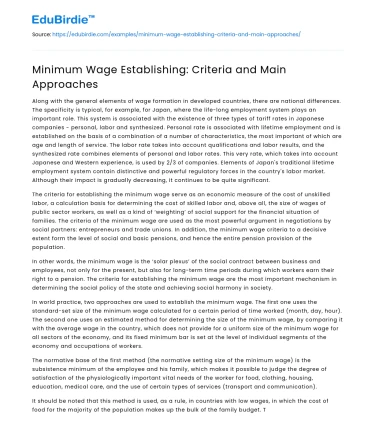Along with the general elements of wage formation in developed countries, there are national differences. The specificity is typical, for example, for Japan, where the life-long employment system plays an important role. This system is associated with the existence of three types of tariff rates in Japanese companies - personal, labor and synthesized. Personal rate is associated with lifetime employment and is established on the basis of a combination of a number of characteristics, the most important of which are age and length of service. The labor rate takes into account qualifications and labor results, and the synthesized rate combines elements of personal and labor rates. This very rate, which takes into account Japanese and Western experience, is used by 2/3 of companies. Elements of Japan's traditional lifetime employment system contain distinctive and powerful regulatory forces in the country's labor market. Although their impact is gradually decreasing, it continues to be quite significant.
The criteria for establishing the minimum wage serve as an economic measure of the cost of unskilled labor, a calculation basis for determining the cost of skilled labor and, above all, the size of wages of public sector workers, as well as a kind of ‘weighting’ of social support for the financial situation of families. The criteria of the minimum wage are used as the most powerful argument in negotiations by social partners: entrepreneurs and trade unions. In addition, the minimum wage criteria to a decisive extent form the level of social and basic pensions, and hence the entire pension provision of the population.
Save your time!
We can take care of your essay
- Proper editing and formatting
- Free revision, title page, and bibliography
- Flexible prices and money-back guarantee
In other words, the minimum wage is the ‘solar plexus’ of the social contract between business and employees, not only for the present, but also for long-term time periods during which workers earn their right to a pension. The criteria for establishing the minimum wage are the most important mechanism in determining the social policy of the state and achieving social harmony in society.
In world practice, two approaches are used to establish the minimum wage. The first one uses the standard-set size of the minimum wage calculated for a certain period of time worked (month, day, hour). The second one uses an estimated method for determining the size of the minimum wage, by comparing it with the average wage in the country, which does not provide for a uniform size of the minimum wage for all sectors of the economy, and its fixed minimum bar is set at the level of individual segments of the economy and occupations of workers.
The normative base of the first method (the normative setting size of the minimum wage) is the subsistence minimum of the employee and his family, which makes it possible to judge the degree of satisfaction of the physiologically important vital needs of the worker for food, clothing, housing, education, medical care, and the use of certain types of services (transport and communication).
It should be noted that this method is used, as a rule, in countries with low wages, in which the cost of food for the majority of the population makes up the bulk of the family budget. The strength of the subsistence minimum method is the detailed-regulated consumption standards for the vital needs of people, which allows, in the presence of strong trade unions, to reasonably build the logic of their position in negotiations with employers and government agencies on the amount of the increase in the minimum wage.
The weak side of this method is the methodological narrowness of the vital needs taken into account, which in practice manifests itself in a meager set of regulated material and cultural needs, which is especially manifested in the underestimation of cultural, educational, medical and spiritual needs.
This approach limits the set of people's needs to the physiological minimum of material resources necessary for survival, and thereby fetters the economic reproductive capabilities of the worker's family, and thereby deprives it of opportunities for its quantitative and qualitative development.
As the criteria for the second method, a comparison of the minimum and average wages is used, which is called the Keitz index. The proportions of this ratio indicate the degree of approximation to the desired level achieved in the country. Typically, in industrialized countries, the Keitz index is in the range of 48-62%. The recommended proportions of this ratio are 50% by the International Labor Organization and 60% by the European Union.
Thus, the Committee on Social Rights of the Council of Europe, commenting on Article 4 of the European Social Charter (which Russia also signed), emphasizes that the ratio of the minimum and average wages (net of taxes) should not be lower than 60%. Only in some cases is it permissible to lower it to 50%.
The choice of methods and criteria for determining the minimum wage has not only important economic but also social significance. Many experts prefer the applied method based on the subsistence minimum, arguing that in conditions of low economic opportunities of the country at the current stage, it allows setting minimum standards for material support, albeit at a physiological minimum. The average wage rate method is considered to be less clear in the regulatory context. You can only partially agree with this approach. After all, it is possible to apply two methods at the same time. Such a combination will enable a more objective presentation of the picture not only in terms of the minimum subsistence amount, but also to implement measures to smooth the differentiation of wages, which serves as a powerful mechanism for increasing social cohesion in society.






 Stuck on your essay?
Stuck on your essay?

